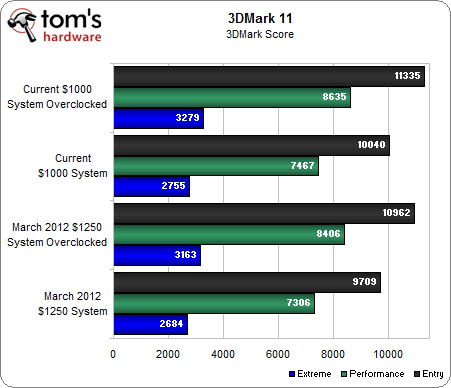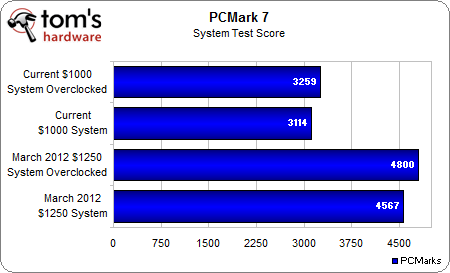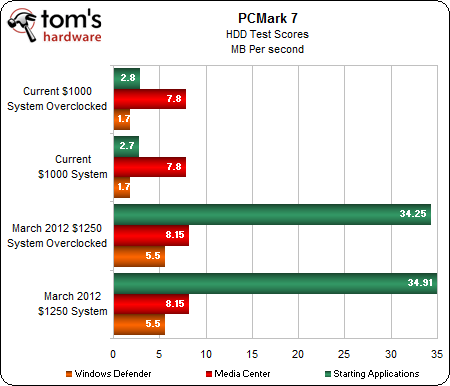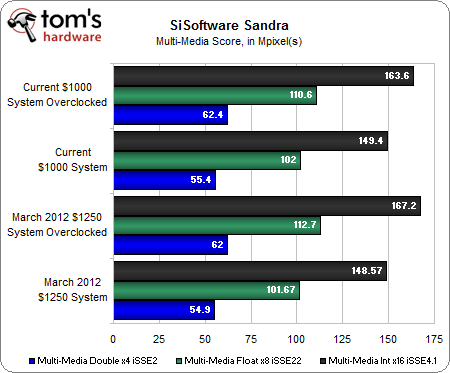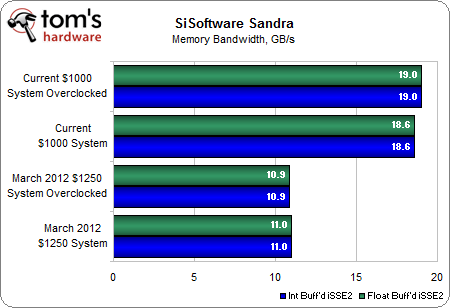System Builder Marathon, June 2012: $1000 Enthusiast PC
Benchmark Results: Synthetics
Considering that these systems employ the same graphics chipset and CPU, the only differences between them are their respective overclocks and the new build's functional dual-channel memory configuration. Because we're isolating 3D performance, last quarter's SSD-equipped setup (which also happened to have more memory) shouldn't get an advantage.
As expected, the results are very close. Interestingly, though, the new build boasts a slight lead (perhaps a result of our processor overclock).
We figured that PCMark would probably be the one suite that'd most clearly favor the system with an SSD. These results would suggest that this build is pretty slow, but of course the synthetic is going to put more emphasis on certain subsystems. In reality, it's hard to tell them apart, aside from the workloads where SSDs excel: boot-up, app-launch, and overall responsiveness.
SiSoftware's Sandra diagnostic tests pure CPU and memory performance, so the SSD doesn't play a role here. The processor results are predictably very close, but the memory bandwidth metric demonstrates just how much throughput we were losing on our previous build due to its faulty motherboard.
Get Tom's Hardware's best news and in-depth reviews, straight to your inbox.
Current page: Benchmark Results: Synthetics
Prev Page Test System And Benchmarks Next Page Benchmark Results: Media EncodingDon Woligroski was a former senior hardware editor for Tom's Hardware. He has covered a wide range of PC hardware topics, including CPUs, GPUs, system building, and emerging technologies.
-
ddan49 I personally think they went a little TOO overboard on the GPU. Sure, it'll tear through games... but at 4GB of RAM, a non-overclockable i5 CPU, and a P67 motherboard... well... meh...Reply -
ddan49 ReplyWe have two very similar systems here, and the new one has to make due with 4 GB less RAM, no SSD, and no aftermarket CPU cooler.
May want to put "do" in there, instead ;) -
mayankleoboy1 not criticizing, but this build looks like a half-hearted attempt.Reply
Basically the whole article tests the improvements of a single channel over a dual channel RAM. -
mousseng I realize the SBM is sponsored by Newegg, so that means they're only able to get what they can from Newegg?Reply
Because if not, I would posit that the i5-2380p is a better CPU choice than the i5-2400:
1) You've not got a huge need for the IGP, what with the 7970 (I could see it could still have use, but I don't think it would be that helpful)
2) From what I've read on Newegg's page for the 2380p (which they no longer sell), the 2380p is a great overclocker (up to 4.5Ghz according to one reviewer)
3) It costs the same as the 2400, with the same stock clocks
Apart from that, I think it's a pretty solid build. A little too much corner-cutting compared to what I would've chosen, but I'd probably put together something rather standard and boring. -
pistolpete31 mayankleoboy1not criticizing, but this build looks like a half-hearted attempt. Basically the whole article tests the improvements of a single channel over a dual channel RAM.Reply
Yeah I totally agree, I would have loved to see a 3570k and a gtx 670 because those two seem like the popular choice right now. Who sets this budget anyways? "We didn't wan't to go over" umm is there like a slow painful death if you go over the budget or what? Set the budget higher then. Hope the next round of these is better. -
koshadows I'm not quite sure how I should respond to both of the system builders comment section from this week. Gtx 670 wasn't available, we know. Stop beating this dead horse. Its just like last quarter's waterfall of "why no 680????"Reply
As of right now at the time of this post, the sapphire 7970 o/c on newegg is at $480. http://www.newegg.com/Product/Product.aspx?Item=N82E16814102982 So i can only assume whatever price hike has been dealt with?
Good job on making a computer perform about the same for $250 less! I'm sure if I was to build a computer right now this would give quite a bit of breathing room. Not everyone has quarter of a grand to throw around.
Downside is it does feel like you guys ran outta ideas on new combinations. I think I'd be kind of interested in either a SLI config 560 ti or 7850s. But the 7850 would've pushed it past budget I think. I'd still vote on the SSD though!

